Abstract
The integration of artificial intelligence (AI) and virtual reality (VR) in high-risk training simulations represents a significant advance in preparing professionals for critical situations. This study presents an exhaustive bibliometric review of the scientific literature published between 2015 and 2025, analyzing the trends, impact, and evolution of these technologies in various high-risk fields. The methodology employed included systematic searches in databases, such as Web of Science and Scopus, using keywords related to AI, VR, and high-risk simulation. Here, 700 articles were analyzed, applying co-citation analysis and scientific mapping techniques. The results reveal an exponential growth in publications on this topic, with an average annual increase of 5.54%. The following main thematic clusters were identified: emergency medicine, aviation, nuclear industry, and disaster response. The co-authorship analysis showed strong international collaboration, with the United States, China, and Germany standing out as leaders in research. This study provides a comprehensive view of the current state of research, identifying the main areas, gaps, and opportunities in the application of AI and VR in high-risk training.
1. Introduction
Artificial intelligence (AI) is a multidisciplinary field of computer science that seeks to create systems and machines capable of performing tasks that traditionally require human intelligence, such as learning, reasoning, perception, language interpretation, and decision making [1,2,3]. Using complex algorithms, neural networks, and machine learning techniques, AI allows computers to process large volumes of data, recognize patterns, predict behaviors, and progressively self-learn [4]. Its applications span a variety of sectors, from healthcare and scientific research to industry, finance, education, and entertainment, radically transforming the way we interact with technology and solve complex problems [5,6].
Virtual reality (VR) is an immersive technology that generates simulated three-dimensional digital environments, allowing users to experience computer-generated artificial environments with a sense of real presence [7]. Through special devices, such as VR glasses or headsets, a complete sensory experience is created that envelops the user, offering interactivity and control over the virtual world [8]. This technology goes beyond entertainment, finding applications in fields such as medicine, education, architecture, and professional training, where it allows complex scenarios to be simulated without real risks [9].
VR and AI are experiencing exponential growth and showing transformative potential in various sectors [10]. The integration of AI into VR will enable the creation of personalized and adaptive immersive experiences in real time, significantly improving human–machine interaction [11]. In healthcare, for example, AI is expected to optimize medical diagnoses and enable complex simulations, while in entertainment, the combination of these technologies could generate completely personalized content, such as video games that are tailored to the user’s emotions [12,13,14]. In addition, VR and AI are anticipated to drive advances in fields such as autonomous driving and architectural design, offering innovative and efficient solutions to complex challenges [15]. AI is playing a crucial role in the development of the metaverse and augmented reality, enabling more intuitive and personalized interactions in virtual environments [16].
In the field of training, AI and VR are revolutionizing teaching and learning methods [17]. VR has become a valuable tool for professional and technical training, offering immersive experiences that improve knowledge retention and allow dangerous situations to be simulated without real risks [18]. The integration of these technologies in education is radically transforming the educational landscape, enabling hands-on learning without borders and personalization of learning tailored to the needs of each student. In addition, the combination of AI and VR is creating new opportunities in sectors such as medicine, engineering, and aeronautics, where they are used to train professionals in complex procedures and advanced simulations [19].
The integration of AI and VR is revolutionizing different areas of training, including training and high-risk training, offering significant improvements (Figure 1) [20,21]. In this regard, VR offers immersive environments that allow dangerous scenarios to be simulated without real risks, being especially useful in medicine [22], aviation [23,24], accidents [25,26], and natural disaster response [13]. For its part, AI enhances these simulations with predictive analysis, personalization, and process automation [27,28]. In the context of high-risk training, the combination of VR and AI makes it possible to create advanced simulations for medical operations, crisis situations, and elite sports training [29]. These technologies significantly improve knowledge and skill retention [30]. In addition, their application in sectors such as the nuclear industry and emergency response is transforming traditional training methods, allowing professionals to practice complex procedures in safe and controlled environments [31].
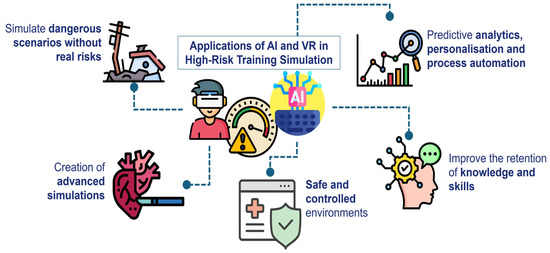
Figure 1.
Improvements offered by the integration of AI and VR in high-risk training.
The integration of artificial intelligence (AI) and virtual reality (VR) in high-risk training simulations has transformed pedagogical approaches by linking with learning theories, such as constructivism and cognitive neuroscience [32]. Immersive VR simulations allow users to interact with hyper-realistic environments that replicate critical situations, facilitating experiential learning [33]. This approach aligns with constructivist theory, where knowledge is constructed through active interaction with the environment [34]. VR not only reproduces physical scenarios but also incorporates emotional and sensory elements, activating neuropsychological mechanisms linked to memory and decision making under stress, as indicated by studies in behavioral neurology [35].
Several studies have conducted a bibliometric review on the evolution of the application of VR and AI in education and training. Manchada et al. (2024) [36] examine the current academic relationship between computer vision and deep artificial intelligence (AI) in the context of virtual reality, augmented reality, and mixed reality. Xu et al. (2024) [37] discuss the role that augmented reality (AR) plays in vocational education and training in the smart era, as well as its significant impact on cultivating talents with innovative and holistic skills. Finally, Hanid et al. (2025) [38] discuss how Extended Reality (XR) is transforming education, offering unparalleled insights to enhance teaching and learning processes. However, no scientific references have been found that jointly review the impact that AI and VR are having beyond the traditional educational system in high-risk training simulation situations.
In view of this scenario, the main objective of this research is to conduct a comprehensive bibliometric review on the applications of AI and VR in high-risk training simulations. As shown in previous research works [39,40], this study seeks to map and analyze scientific production in this emerging field, identifying the research trends, the most influential authors and institutions, and the most prominent areas of application. Through the analysis of bibliometric indicators, it is intended to provide a comprehensive vision of the current state of research, highlight existing gaps and opportunities for future studies [41].
2. Materials and Methods
The bibliometric review began with an exhaustive search in the Web of Science and Scopus databases. Key terms related to “artificial intelligence and virtual reality in high-risk training” were used, including variations and synonyms, combined using Boolean operators (e.g., “AI” OR “VR” AND “training” OR “risk”). Table 1 presents the search string defined for this research. Full metadata of the publications were exported, including titles, authors, affiliations, abstracts, keywords, citations, and references.

Table 1.
Search string.
The PRISMA protocol is a fundamental guide for the conduct and presentation of systematic reviews. Updated in 2020, PRISMA provides a four-phase flowchart that helps improve the transparency, quality, and value of bibliometric reviews [42,43]. The implementation of the PRISMA protocol is crucial to ensure the reproducibility and integrity of systematic reviews [44]. The detailed PRISMA flow diagram is presented in Figure 2. The initial number of documents identified in Scopus and WoS was 2495. Subsequently, a total of 239 duplicate documents were removed. Of the 2256 eligible results, a total of 1456 were excluded based on the seven defined exclusion criteria. In a bibliometric analysis conducted under the PRISMA protocol, the exclusion criteria are mainly justified to ensure the quality, relevance, and reproducibility of the results [3]. Consequently, the collection of documents analyzed in this study included 700 results from the year 2015 to 2025.

Figure 2.
Flowchart following the PRISMA 2020 protocol for the identification of studies via databases and registers.
The bibliometric analysis was performed using the specialized Bibliometrix tools (R package 4.4.2) for statistical calculations. Key bibliometric indicators were generated, such as the number of publications per year, the impact factor of the journals, the h-index of the authors, and co-citation analysis. Keyword co-occurrence maps were constructed to identify the main and emerging themes in the field. In addition, an analysis of international collaboration was carried out, visualizing the co-authorship networks between countries and institutions [39,45].
Subsequently, the interpretation of the results obtained was carried out through topic analysis. Different studies have used this analysis to identify trends, obsolete topics, etc. [46,47]. Topic analysis in bibliometric studies is a fundamental technique for identifying and examining the main thematic areas and research trends in a specific field. These approaches allow not only to identify topics but also to analyze their temporal evolution and the relationships between different areas of research.
To calculate the relative frequency (fi) in topic analysis, the following formula is used [46]:
where fi is the frequency of existence of the topic analyzed for a given time frame, ni is the initial value of the article number, and N is the total number of articles.
The growth index (G) is a measure used to calculate the rate of change of a variable over time [48]. The general formula for the growth index can be expressed as follows. This formula calculates the relative change in the variable from its initial value to its final value, expressed as a percentage of the initial value.
where G is expressed as a percentage, ni is the initial value of the variable, and nf is the final value of the variable.
Finally, the Simpson index (D) is used to determine the thematic diversity index [49]. This index allows the variety and distribution of topics to be analyzed, identifying possible concentrations of topics or, on the contrary, a balanced distribution of them.
where pi is the proportion of results assigned to a topic and S is the total number of topics identified.
3. Results
This section presents a detailed bibliometric analysis of the research environment on AI and VR applications in high-risk training, underlining trends in publication growth, scientific production, and the most relevant scientific journals, authors, and countries. Moreover, it provides a comprehensive perspective on the field’s evolution, bridging diverse research directions and showcasing the global influence of advancements in immersive training technologies.
First, Figure 3 provides a summary of the general bibliometric data from 2015 to 2025. The dataset consists of 700 documents sourced from 429 different outlets, with an annual growth rate of 5.54%. The average citations per document stand at 12.78, indicating a moderate impact within the scientific community. Collaboration trends reveal a strong inclination toward multi-author publications, with an average of 4.72 co-authors per document. International co-authorship accounts for 10.86%, highlighting the global relevance of research in this domain. As previously stated, all analyzed documents are articles, including five book chapters and twelve early-access articles.
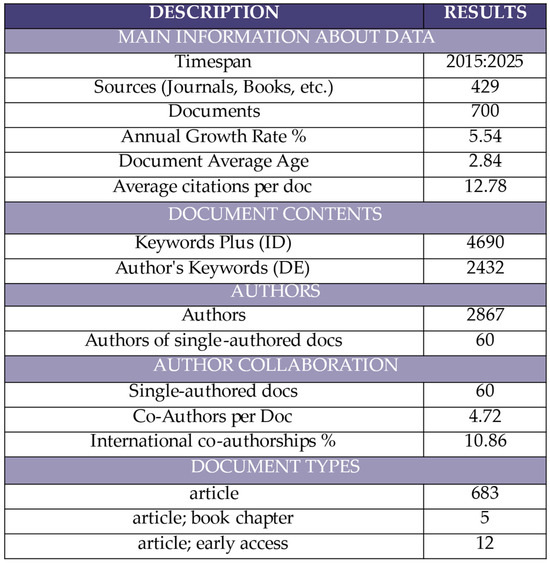
Figure 3.
Overview of bibliometric output on AI and VR in high-risk training (2015–2025).
The annual scientific production and citation evolution over the studied period are indicated in Figure 4. The number of published documents has exhibited an exponential increase, with a significant surge in 2022 (124 documents), 2023 (141 documents), and 2024 (225 documents). Despite an increase in document creation, there has been a downward trend in the mean total citations per year (MeanTCperYear) and per article (MeanTCperArt). This implies that although research production has increased, it may take longer for citations to accrue for more recent articles, or the fundamental significance of older studies may have been greater. A move toward specialized research topics with lower general citation rates may also be indicated by the reduction in citation metrics.
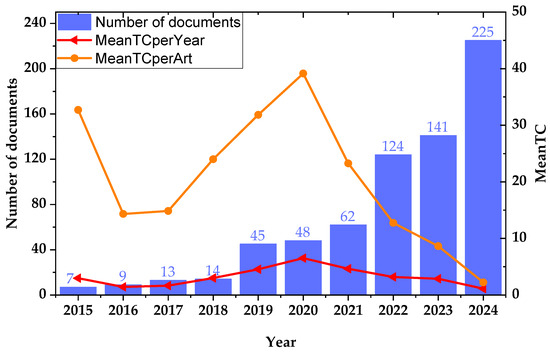
Figure 4.
Research growth and citation trends in AI and VR for high-risk training.
The most relevant scientific journals in the research field are presented in Figure 5. In this regard, IEEE Access emerges as the most prominent journal, with 37 published documents, followed by Sensors (12), PLoS ONE (11), and Applied Sciences (9). The presence of journals such as Computational Intelligence and Neuroscience and IEEE Transactions on Neural Systems and Rehabilitation Engineering suggests a strong interdisciplinary approach, combining AI, neuroscience, and immersive simulation technologies.
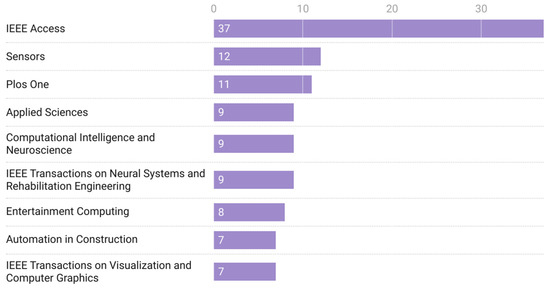
Figure 5.
Leading scientific journals in AI and VR for high-risk training.
Following the relevant scientific journals, Table 2 presents the most impactful scientific journals based on bibliometric indicators, including the h-index, g-index, m-index, total citations (TCs), and number of publications (NPs). IEEE Access leads in terms of citation impact, with an h-index of 12, a g-index of 25, and a total of 634 citations across 76 publications. Other high-impact journals include Automation in Construction, PLoS ONE, and IEEE Robotics and Automation Letters. These findings demonstrate the growing importance of AI and VR research in interdisciplinary domains, especially in the domains of computational intelligence, engineering, and automation.

Table 2.
High-impact scientific journals in AI and VR for high-risk training.
A high emphasis on technological developments and their real-world application in training settings is indicated by the abundance of IEEE-related journals. The presence of transversal journals, such as Applied Sciences, suggests a wider scope, even though technology-focused journals still predominate. Furthermore, as was already known, the growing number of publications in these journals is indicative of the growing use of AI-powered virtual simulations in dangerous settings.
The temporal growth of scientific journal output is visually depicted in Figure 6, pointing out the rising publication rates in prominent journals like IEEE Access, Sensors, PLoS ONE, Applied Sciences, and Computational Intelligence and Neuroscience. The data indicate that research production has been generally increasing since 2015, with a noticeable increase starting in 2020. This surge coincides with the broader adoption of AI and VR in high-risk training applications, which reveals the field’s increasing importance and interdisciplinary expansion.
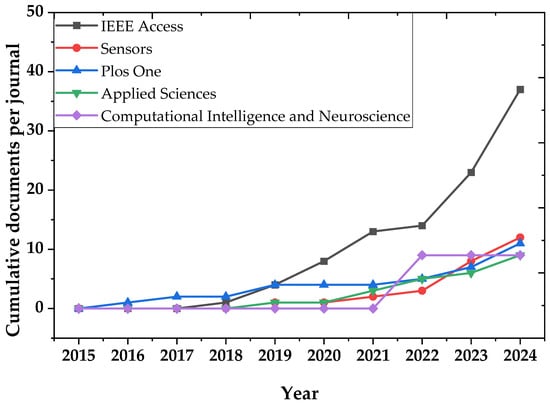
Figure 6.
Growth trends in scientific journals and key contributors.
Table 3 ranks the top authors in the field based on the h-, g-, and m-index, highlighting S. Lee’s significant influence with an h-index of 8, followed by J. Wang (6) and M.R.F. Del (5). The presence of authors with relatively high citation counts and publication outputs suggests a growing network of influential researchers contributing to the advancement of AI and VR technologies in high-risk training. The distribution of authorship impacts highlights both established and emerging individuals in the field. The leading authors demonstrate a balance between publication volume and citation influence, bolstering their influence in shaping the research. The observed growth in scientific output, as reflected in both Figure 6 and Table 3, underscores the increasing relevance in the field of study.

Table 3.
Leading researchers in AI and VR for high-risk training.
The distribution of affiliations shown in Figure 7 indicates that universities in North America and Asia lead research in AI and VR applied to high-risk training. McGill University tops the list with 20 publications, suggesting a strong focus on medical and security simulations. The National University of Singapore and National Central University reflect the research boom in Asia, driven by investments in technology and government digitization strategies. In addition, the presence of universities, such as Stanford and Zhejiang, focuses the participation of institutions with a background in technological innovation. The inclusion of European and Middle Eastern institutions, such as IRCCS Istituto Auxologico Italiano and King Abdulaziz University, indicates a growing interest in the application of these technologies globally, particularly in healthcare and vocational training.

Figure 7.
Leading affiliations in AI and VR for high-risk training.
Figure 8 shows the countries by the corresponding authors with the highest number of citations. China dominates in the number of publications, with 27.1% of the total, evidencing its large investment in emerging technology, followed by the US and Korea. Importantly, there is a trend towards more frequent international collaborations in European countries, such as Germany and the UK, where the percentages of collaborative publications (MCPs) are notably high. This suggests that while China and the US lead in volume, Europe focuses on scientific cooperation to increase the impact and quality of studies. Furthermore, the participation of countries such as Italy and Spain, although lower in terms of the number of publications, suggests a strong interest in the related field.

Figure 8.
Country distribution of corresponding authors in AI and VR for high-risk training.
In relation to the previous results, Table 4 presents the leading researchers identified in the field, along with their respective nationalities and institutional affiliations. A significant concentration of contributions is observed in China and Canada, highlighting the prominence of Southeast University, McGill University, and other institutions, such as National Yang Ming Chiao Tung University in Taiwan. This distribution emphasizes the international dimension of research collaboration and leadership within the field.

Table 4.
Leading researchers with their nationality and affiliation.
The most cited countries are indicated in Figure 9. Here, despite China’s high output, the US leads in total citations and average citations per article (20.3), indicating greater influence and recognition of its research. Korea and the UK also have high citation averages (15.7 and 16.1, respectively), suggesting that their output, although lower in quantity, is highly relevant and referenced in the scientific community. Singapore and Italy stand out for their relative impact, with an average number of citations that demonstrates the quality of their studies. The difference between the number of publications and impact reflects the fact that a massive output does not always translate into greater scientific relevance. These data reflect an expanding AI and VR research landscape, with a balance between mass production (China), academic influence (US), and international collaborations (Europe and Asia).
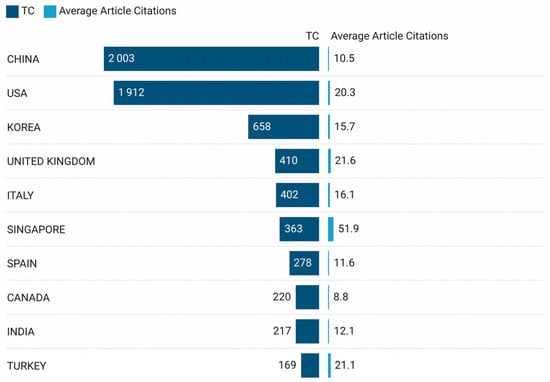
Figure 9.
Leading cited countries in AI and VR for high-risk training.
Table 5 presents the most highly cited publications, including total citations (TCs), annual citation rate (TCs per year), and normalized TCs. Y. Ma et al. [50] lead with 409 citations and an annual rate of 68.17, demonstrating their significant influence. Other notable works, such as those by A. Mohaisen et al. [51] and F.P. Rahimian et al. [52], exhibit steady impact with TCs per year values of 17.00 and 29.67, respectively. Normalized TC values emphasize citation impact, with Y. Ma et al. [50] (10.45) and Aslan et al. [53] (5.80) among the highest. Emerging studies, including those by A. Amini et al. [54] and K. Kang et al. [55], show strong citation performance, indicating evolving research on AI-driven immersive training environments.

Table 5.
Highly cited publications on AI and VR for high-risk training.
Finally, the analysis of the funding acknowledgments associated with the selected publications reveals a diverse array of financial support, spanning governmental agencies, academic institutions, private foundations, and industry stakeholders. Notable funding bodies include the National Institutes of Health (NIH, USA), the National Science Foundation (NSF, USA), the China Scholarship Council, and national research organizations in Japan, Korea, and Saudi Arabia. Additionally, several universities and philanthropic institutions, such as the Helmsley Charitable Trust and Princess Nourah Bint Abdulrahman University, were identified as key contributors. A few publications also acknowledged support from private companies, including NVIDIA and Adobe, particularly in research focused on virtual reality technologies and simulation environments.
Interestingly, a substantial portion of entries (the most frequent funding declaration) reported “No Statement Available”, suggesting either a lack of financial disclosure or the absence of dedicated funding. The funding mechanisms observed in this dataset have had a marked influence on the nature and scope of the research activities. Public funding programs often aligned with national strategic priorities, promoting research in areas such as smart healthcare, education, and digital innovation. Institutional and cross-border collaborations were also facilitated through international funding frameworks. Furthermore, several acknowledgments highlighted support for open-access publishing, contributing to the dissemination and visibility of the research.
4. Discussion
The importance of analyzing the occurrence of keywords lies in identifying key terms that are central to the topic [46]. By analyzing the frequency of each word, the most relevant topics can be identified. To organize the keywords according to their occurrence, they are grouped into the following ranges: very high (+100), high (50–99), medium (20–49), and low (10–19), as shown in Table 6. The results show that the keywords grouped in the very high range (VR, deep learning, AI) represent central and widely discussed concepts. These words reflect emerging and disruptive technologies that are transforming multiple sectors, such as education, health, and industry. Their high frequency suggests that they are key topics of general interest and probably constitute the focus of the research or discussions analyzed. On the other hand, high-ranking words (such as machine learning, reinforcement learning, simulation, and augmented reality) complement these core technologies by focusing on specific applications and related concepts, indicating significant interest in how these technologies are implemented in practical contexts.

Table 6.
Keyword occurrence analysis.
In contrast, words classified in the medium and low ranges encompass more specific or specialized terms that, while less frequent, are essential to understanding the technical details or applications of the core technologies. For example, terms such as “robotics”, internet of things”, “neural networks”, and “optimization” in these ranks reflect more focused research areas or key technical components within general topics. The diversity of terms in the lower ranks also suggests an interdisciplinary ecosystem, where concepts such as “education”, “clinical competence”, or “human computer interaction” connect technology with human and societal applications. Taken together, these results highlight both central themes and complementary areas that enrich the overall picture of the analysis.
The generation of topics from keyword analysis is a fundamental practice that goes beyond the simple categorization of terms. This process allows for a deeper and more structured understanding of the content. By grouping related keywords into topics, a conceptual framework is created that reflects the interconnectedness of ideas within a specific field. In the present research, the following topics have been defined (Table 7): T1—AI and machine learning; T2—virtual and augmented reality; T3—education and training; T4—computing and technology; T5—health sciences and biomedicine; and T6—systems and simulations.

Table 7.
Defined topics.
This thematic clustering not only improves the organization of content but also reveals content opportunities that might go unnoticed when analyzing keywords in isolation. The topic of AI and machine learning (T1) is justified by its broad application in pattern recognition, predictive analytics, and natural language processing, transforming training. Virtual and augmented reality (T2) enriches educational and entertainment experiences, while education and training (T3) focuses on how these technologies enhance personalized and autonomous learning.
The topic of computing and technology (T4) covers advances in hardware and software that drive these innovations. Health sciences and biomedicine (T5) apply advanced technologies for medical diagnostics and training through virtual simulations. Finally, systems and simulations (T6) allow recreating virtual environments for training and education, optimizing industrial processes, and recreating historical or scientific scenarios. These topics reflect current trends in technology and their impact on different areas, demonstrating how they converge to create innovative solutions that transform the way we learn, work, and live. Their interrelationship shows how technology is integrating into all aspects of society, improving efficiency and human experience.
In terms of relative frequency (Equation (1)), the use of a three-color scale based on the 10th, 50th, and 90th percentiles (Figure 10) highlights the distribution of the data as a function of time. The 10th percentile represents the value below which 10% of the data are found, the 50th percentile (also known as the median) divides the dataset into two equal halves, and the 90th percentile indicates the value below which 90% of the data are found.

Figure 10.
Heat map relative frequency—topics.
The results obtained (Figure 10) show a clear trend of growth in interest and development in the field of AI and machine learning since 2015, reaching its highest point in 2024 (0.2439). This sustained increase suggests that this field has gained significant importance compared to the other areas analyzed, consolidating itself as a priority area for research or application. On the other hand, other areas, such as virtual and augmented reality, also show a notable growth, although less pronounced, especially from 2019 onwards, indicating a growing interest in immersive technologies. In contrast, areas such as health sciences and biomedicine, computing and technology, and systems and simulation show low and relatively stable values over time, which could reflect a reduced focus or saturation in these disciplines.
The evolution of the growth factor (Equation (2)) in the different research areas between 2016 and 2024 (Figure 11) reveals interesting and, in some cases, surprising patterns. The field of AI and machine learning stands out as the most dynamic and promising, showing sustained and significant growth throughout the decade, with an extraordinary peak of 267% in 2019. This steady growth reflects the increasing importance and application of AI in various sectors, from industry to academic research. On the other hand, areas such as virtual and augmented reality, as well as education and training, show considerable volatility, with periods of explosive growth followed by significant contractions. This could indicate the cyclical nature of these technologies, possibly influenced by factors such as market adoption, technological advances, or changes in research funding policies.
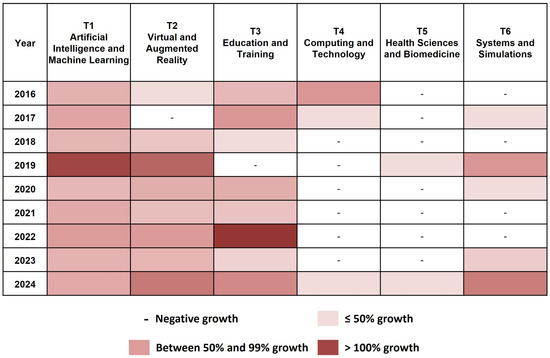
Figure 11.
Heat map growth index—topics.
Finally, the results of Simpson’s Diversity Index (Equation (3)) between 2015 and 2024 (Figure 12) show a general trend of decreasing subject matter diversity, with significant fluctuations over the years. The index starts in 2015 with a relatively high value (0.612), indicating moderate diversity, but experiences a progressive decline to reach its lowest point in 2021 (0.308), reflecting a marked reduction in diversity. This change could be related to an increasing dominance of certain topics, such as education and training (T3), AI and machine learning (T4), and virtual and augmented reality (T5). Although there is a slight recovery in later years, such as in 2022 (0.403) and 2025 (0.402), the values do not return to the initial levels, suggesting that the subject has not managed to re-establish its original diversity.
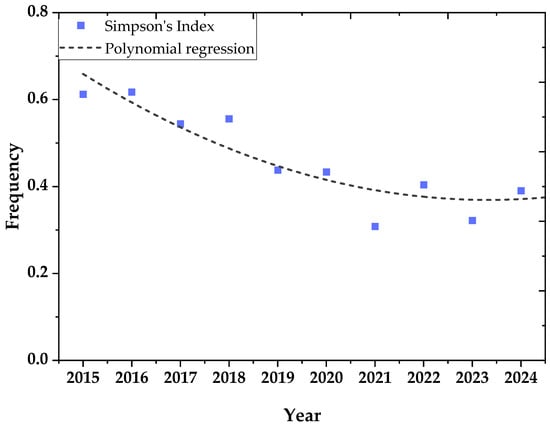
Figure 12.
Simpson’s index evolution.
The observed fluctuations in the index could be indicative of significant structural events or changes affecting the composition of the system. For example, the sharp drop between 2019 (0.438) and 2021 (0.308) could signal a consolidation or specialization within the system, while the partial recovery in 2022 and 2025 suggests attempts to diversify or redistribute the topics.
To further explore the application of AI and VR in high-risk simulation training, an analysis of potential areas where AI and VR may have application in high-risk training is also conducted. Table 8 below develops the most relevant areas identified in the selection of the 700 selected articles as follows: (i) medicine and surgery; (ii) industrial safety and emergency management; (iii) education and teacher training; and (iv) industry/manufacturing.

Table 8.
Main areas of application of AI and VR in high-risk training.
The analysis reveals how the field of AI and machine learning has emerged as the dominant area, showing sustained and significant growth since 2015, with an extraordinary peak in 2019. This focus has driven significant advances, especially in high-risk sectors, such as medicine, industrial safety, and manufacturing, where AI and VR have been shown to improve training, safety, and efficiency. In parallel, areas such as virtual and augmented reality have experienced remarkable, although more volatile, growth, indicating a growing interest in immersive technologies, but they are subject to fluctuations and are possibly influenced by market factors and technological advances (Figure 13).

Figure 13.
Trends in the applications of AI and VR in high-risk training simulations.
However, this trend toward the dominance of certain technology areas has led to an overall decline in subject diversity, as evidenced by the drop in Simpson’s Diversity Index between 2015 and 2024. This phenomenon suggests a concentration of resources and interest in specific fields, mainly in AI, machine learning, and, to a lesser extent, virtual and augmented reality. Although a slight recovery in diversity is observed towards the end of the period analyzed, the initial levels of 2015 are not reached. This raises important considerations about the future direction of technological research and development, suggesting the need for strategies that encourage greater diversification to maintain a balanced and resilient innovation ecosystem.
To reduce the concentration of contributions from countries such as China and Canada, it is essential to focus on technological solutions that are accessible and adapted to their contexts [66]. The development and distribution of low-cost virtual reality hardware would allow schools, training centers, and rural communities to access immersive experiences without incurring large expenses [67]. In parallel, the use of scalable cloud-based AI tools offers the possibility to process large volumes of data and run complex models without the need to invest in expensive local infrastructure, thus facilitating the expansion of AI projects in a flexible and affordable way [68]. In addition, the promotion of AI-based educational platforms is key to democratizing digital knowledge and skills [69].
Future research on the application of AI and VR in high-stakes training simulations should focus on optimizing the synergy between immersive technologies and learning theories. A key area is to explore how AI and VR algorithms can dynamically adapt virtual scenarios from neuro-physiological data, linking these adjustments with principles from educational neuroscience and cognitive load theory. Another priority line is to investigate the ethical and psychological aspects of the use of AI and VR in high-stakes training, particularly in the collection of sensitive data and its alignment with theories such as operant behaviorism or social learning.
5. Conclusions
The integration of artificial intelligence (AI) and virtual reality (VR) has revolutionized training protocols in critical sectors, according to the analysis of 700 scientific articles. The results show an exponential growth of 5.54% in publications between 2019 and 2024, reflecting the technological maturity achieved in fields such as emergency medicine (surgical simulations) and disaster management (training for CBRN incidents). This boom coincides with the adoption of immersive tools that allow high-risk scenarios to be simulated with anatomical accuracy or to replicate industrial emergencies, reducing operating costs and physical exposure. However, the reduction in thematic diversity from 2015 levels risks limiting responsiveness to new challenges and missing emerging opportunities in other less-explored fields.
The co-authored analysis reveals a transdisciplinary collaboration, with notable contributions from the United States in medical simulations, China in industrial applications, and Germany in crisis response systems. The identified thematic clusters—nuclear aviation, disaster response, and emergency medicine—demonstrate how AI-based VR optimizes training through adaptive algorithms, while biometric records allow physiological responses to be evaluated in real time. Cases such as explosive deactivation simulators or virtual patients for surgeries illustrate this technological synergy.
Despite the advances, this study identifies critical gaps: only 18% of research addresses ethical aspects of the use of biometric data, and there is a geographical disparity in access to these technologies, with scarce representation of developing countries. In addition, a trend towards excessive specialization is detected, where 73% of studies focus on sectoral applications without addressing unified theoretical frameworks. This underscores the need for standardized protocols for competency assessment and interoperable systems that integrate generative AI into simulations.
To diversify the concentration of scientific contributions on the application of AI and VR in high-stakes simulation training, it is essential to implement accessible and context-specific solutions. Different strategies, such as low-cost virtual reality hardware and AI tools in the cloud, facilitate the access and expansion of these technologies without large investments. Likewise, AI-based educational platforms are key to democratizing knowledge and digital skills.
As a future horizon, seven priority lines are proposed as follows: (i) the development of hybrid VR/AR environments with haptic feedback to improve realism; (ii) the implementation of explanatory AI models that justify real-time decisions; (iii) longitudinal studies on skill retention; (iv) regulatory frameworks for sensitive data management in training; (v) dynamic adaptation of virtual scenarios based on neurophysiological data obtained with AI and VR; (vi) investigate the ethical and psychological aspects of the use of AI and VR in high-risk training; and (vii) strategies for the democratization of AI and VR in high-stakes simulation training. The convergence between cognitive neurosciences and immersive systems emerges as a promising area for optimizing the learning curve in contexts of extreme pressure.
Author Contributions
Conceptualization, P.F.-A. and D.V.; methodology, P.F.-A., A.d.B. and G.L.; software, P.F.-A. and A.d.B.; validation, G.L. and D.V.; formal analysis, P.F.-A., A.d.B., G.L. and D.V.; investigation, P.F.-A., A.d.B. and D.V.; data curation, P.F.-A. and A.d.B.; writing—original draft preparation, P.F.-A. and A.d.B.; writing—review and editing, G.L. and D.V.; visualization, P.F.-A., A.d.B. and G.L.; supervision, D.V. All authors have read and agreed to the published version of the manuscript.
Funding
This research received no external funding.
Institutional Review Board Statement
Not applicable.
Informed Consent Statement
Not applicable.
Data Availability Statement
The original contributions presented in this study are included in the article; further inquiries can be directed to the corresponding authors.
Conflicts of Interest
The authors declare no conflicts of interest.
References
- Hinojo-Lucena, F.J.; Aznar-Díaz, I.; Cáceres-Reche, M.P.; Romero-Rodríguez, J.M. Artificial Intelligence in Higher Education: A Bibliometric Study on Its Impact in the Scientific Literature. Educ. Sci. 2019, 9, 51. [Google Scholar] [CrossRef]
- Gao, F.; Jia, X.; Zhao, Z.; Chen, C.C.; Xu, F.; Geng, Z.; Song, X. Bibliometric Analysis on Tendency and Topics of Artificial Intelligence over Last Decade. Microsyst. Technol. 2021, 27, 1545–1557. [Google Scholar] [CrossRef]
- Vergara, D.; Lampropoulos, G.; Antón-Sancho, Á.; Fernández-Arias, P. Impact of Artificial Intelligence on Learning Management Systems: A Bibliometric Review. Multimodal Technol. Interact. 2024, 8, 75. [Google Scholar] [CrossRef]
- Woodman, R.J.; Mangoni, A.A. A Comprehensive Review of Machine Learning Algorithms and Their Application in Geriatric Medicine: Present and Future. Aging Clin. Exp. Res. 2023, 35, 2363–2397. [Google Scholar] [CrossRef]
- Pournader, M.; Ghaderi, H.; Hassanzadegan, A.; Fahimnia, B. Artificial Intelligence Applications in Supply Chain Management. Int. J. Prod. Econ. 2021, 241, 108250. [Google Scholar] [CrossRef]
- Javaid, M.; Haleem, A.; Singh, R.P.; Suman, R. Artificial Intelligence Applications for Industry 4.0: A Literature-Based Study. J. Ind. Integr. Manag. 2022, 7, 83–111. [Google Scholar] [CrossRef]
- Extremera, J.; Vergara, D.; Rodríguez, S.; Dávila, L.P. Reality-Virtuality Technologies in the Field of Materials Science and Engineering. Appl. Sci. 2022, 12, 4968. [Google Scholar] [CrossRef]
- Monica, R.; Aleotti, J. Evaluation of the Oculus Rift S Tracking System in Room Scale Virtual Reality. Virtual Real 2022, 26, 1335–1345. [Google Scholar] [CrossRef]
- Antón-Sancho, Á.; Vergara, D.; Fernández-Arias, P. Quantitative analysis of the use of virtual reality environments among higher education professors. Smart Learn. Environ. 2024, 11, 13. [Google Scholar] [CrossRef]
- Luck, M.; Aylett, R. Applying Artificial Intelligence to Virtual Reality: Intelligent Virtual Environments. Appl. Artif. Intell. 2000, 14, 3–32. [Google Scholar] [CrossRef]
- Von Ende, E.; Ryan, S.; Crain, M.A.; Makary, M.S. Artificial Intelligence, Augmented Reality, and Virtual Reality Advances and Applications in Interventional Radiology. Diagnostics 2023, 13, 892. [Google Scholar] [CrossRef] [PubMed]
- Kuwaiti, A.; Nazer, A.; Al-Reedy, K.; Al-Shehri, A.; Al-Muhanna, S.; Subbarayalu, A.; Al Muhanna, A.V.; Al-Muhanna, D.; Al Kuwaiti, A.; Nazer, K.; et al. A Review of the Role of Artificial Intelligence in Healthcare. J. Pers. Med. 2023, 13, 951. [Google Scholar] [CrossRef] [PubMed]
- Bohr, A.; Memarzadeh, K. The Rise of Artificial Intelligence in Healthcare Applications. In Artificial Intelligence in Healthcare; Academic Press: Cambridge, MA, USA, 2020; pp. 25–60. [Google Scholar] [CrossRef]
- Stamer, T.; Steinhäuser, J.; Flägel, K. Artificial Intelligence Supporting the Training of Communication Skills in the Education of Health Care Professions: Scoping Review. J. Med. Internet Res. 2023, 25, e43311. [Google Scholar] [CrossRef] [PubMed]
- Alahi, M.E.E.; Sukkuea, A.; Tina, F.W.; Nag, A.; Kurdthongmee, W.; Suwannarat, K.; Mukhopadhyay, S.C. Integration of IoT-Enabled Technologies and Artificial Intelligence (AI) for Smart City Scenario: Recent Advancements and Future Trends. Sensors 2023, 23, 5206. [Google Scholar] [CrossRef]
- Ahuja, A.S.; Polascik, B.W.; Doddapaneni, D.; Byrnes, E.S.; Sridhar, J. The Digital Metaverse: Applications in Artificial Intelligence, Medical Education, and Integrative Health. Integr. Med. Res. 2023, 12, 100917. [Google Scholar] [CrossRef]
- Chen, Z. Artificial Intelligence-Virtual Trainer: Innovative Didactics Aimed at Personalized Training Needs. J. Knowl. Econ. 2023, 14, 2007–2025. [Google Scholar] [CrossRef]
- Liaw, S.Y.; Tan, J.Z.; Lim, S.; Zhou, W.; Yap, J.; Ratan, R.; Ooi, S.L.; Wong, S.J.; Seah, B.; Chua, W.L. Artificial Intelligence in Virtual Reality Simulation for Interprofessional Communication Training: Mixed Method Study. Nurse Educ. Today 2023, 122, 105718. [Google Scholar] [CrossRef]
- Gursel, E.; Reddy, B.; Khojandi, A.; Madadi, M.; Coble, J.B.; Agarwal, V.; Yadav, V.; Boring, R.L. Using Artificial Intelligence to Detect Human Errors in Nuclear Power Plants: A Case in Operation and Maintenance. Nucl. Engin. Tech. 2023, 55, 603–622. [Google Scholar] [CrossRef]
- Antel, R.; Abbasgholizadeh-Rahimi, S.; Guadagno, E.; Harley, J.M.; Poenaru, D. The Use of Artificial Intelligence and Virtual Reality in Doctor-Patient Risk Communication: A Scoping Review. Patient Educ. Couns. 2022, 105, 3038–3050. [Google Scholar] [CrossRef]
- Amokrane, K.; Lourdeaux, D.; Barthès, J.P.; Burkhardt, J.M. An Intelligent Tutoring System for Training and Learning in a Virtual Environment for High-Risk Sites. In Proceedings of the 20th IEEE International Conference on Tools with Artificial Intelligence (ICTAI), Dayton, OH, USA, 3–5 November 2008; Volume 2, pp. 185–193. [Google Scholar] [CrossRef]
- Small, S.D.; Wuerz, R.C.; Simon, R.; Shapiro, N.; Conn, A.; Setnik, G. Demonstration of High-fidelity Simulation Team Training for Emergency Medicine. Acad. Emerg. Med. 1999, 6, 312–323. [Google Scholar] [CrossRef]
- Gómez-Cambronero, Á.; Miralles, I.; Tonda, A.; Remolar, I. Immersive Virtual-Reality System for Aircraft Maintenance Education: A Case Study. Appl. Sci. 2023, 13, 5043. [Google Scholar] [CrossRef]
- Szóstak, M.; Mahamadu, A.M.; Prabhakaran, A.; Pérez, D.C.; Agyekum, K. Development and testing of immersive virtual reality environment for safe unmanned aerial vehicle usage in construction scenarios. Saf. Sci. 2024, 176, 106547. [Google Scholar] [CrossRef]
- Hadipriono, F.C.; Duane, J.W.; Nemeth, Z.A.; Won, S. Implementation of a virtual environment for traffic accident simulation. J. Intell. Fuzzy Syst. 2003, 14, 191–202. [Google Scholar] [CrossRef]
- Rubio-Tamayo, J.L.; Gertrudix Barrio, M.; García García, F. Immersive Environments and Virtual Reality: Systematic Review and Advances in Communication, Interaction and Simulation. Multimodal Technol. Interact. 2017, 1, 21. [Google Scholar] [CrossRef]
- Abdelalim, A.M.; Essawy, A.; Sherif, A.; Salem, M.; Al-Adwani, M.; Abdullah, M.S. Optimizing Facilities Management Through Artificial Intelligence and Digital Twin Technology in Mega-Facilities. Sustainability 2025, 17, 1826. [Google Scholar] [CrossRef]
- Vergara, D.; del Bosque, A.; Lampropoulos, G.; Fernández-Arias, P. Trends and Applications of Artificial Intelligence in Project Management. Electronics 2025, 14, 800. [Google Scholar] [CrossRef]
- Stirling, E.R.B.; Lewis, T.L.; Ferran, N.A. Surgical Skills Simulation in Trauma and Orthopaedic Training. J. Orthop. Surg. Res. 2014, 9, 126. [Google Scholar] [CrossRef]
- Rashid, A.B.; Kausik, A.K.; Al Hassan Sunny, A.; Bappy, M.H. Artificial Intelligence in the Military: An Overview of the Capabilities, Applications, and Challenges. Int. J. Intell. Syst. 2023, 2023, 8676366. [Google Scholar] [CrossRef]
- Sethu, M.; Kotla, B.; Russell, D.; Madadi, M.; Titu, N.A.; Coble, J.B.; Boring, R.L.; Blache, K.; Agarwal, V.; Yadav, V.; et al. Application of Artificial Intelligence in Detection and Mitigation of Human Factor Errors in Nuclear Power Plants: A Review. Nucl. Technol. 2023, 209, 276–294. [Google Scholar] [CrossRef]
- Gkintoni, E.; Antonopoulou, H.; Sortwell, A.; Halkiopoulos, C. Challenging Cognitive Load Theory: The Role of Educational Neuroscience and Artificial Intelligence in Redefining Learning Efficacy. Brain Sci. 2025, 15, 203. [Google Scholar] [CrossRef]
- Harasim, L. Learning Theories: The Role of Epistemology, Science, and Technology. In Learning, Design, and Technology; Spector, J.M., Lockee, B.B., Childress, M.D., Eds.; Springer: Cham, Switzerland, 2023. [Google Scholar] [CrossRef]
- Fareed, O.; Anis, M.I. A hyper-realistic virtual environment for robots training. Prog. Artif. Intell. 2025, 14, 1–10. [Google Scholar] [CrossRef]
- Rizzo, A.A.; Schultheis, M.; Kerns, K.A.; Mateer, C. Analysis of assets for virtual reality applications in neuropsychology. Neuropsychol. Rehabil. 2004, 14, 207–239. [Google Scholar] [CrossRef]
- Manchanda, R.; Sharma, J.; Kumar, N.; Aggarwal, G. Computer Vision and AI, with Immersive Technologies in Education and Training: A Bibliometric Analysis. In Proceedings of the 4th International Conference on Technological Advancements in Computational Sciences (ICTACS), Tashkent, Uzbekistan, 13–15 November 2024; pp. 1650–1657. [Google Scholar]
- Xu, Y.; Mao, D.; Wang, C. XR Technologies in vocational education and training research (2000–2024): A Bibliometric Review. In Proceedings of the 16th International Conference on Education Technology and Computers, Porto, Portugal, 18–21 September 2024; pp. 76–83. [Google Scholar]
- Hanid, M.F.A.; Zakaria, M.I.; Hassan, R. The advancement of extended reality in education: Insights from a 2019–2024 bibliometric analysis. In Multimedia Tools and Applications; Springer: Berlin/Heidelberg, Germany, 2025; pp. 1–25. [Google Scholar] [CrossRef]
- Agyei, V.; Adom-Asamoah, G.; Poku-Boansi, M. Sustainable Transportation in Africa: A Bibliometric, Visualisation and Thematic Analysis. J. Clean Prod. 2024, 462, 142727. [Google Scholar] [CrossRef]
- Li, X.; Lei, L. A Bibliometric Analysis of Topic Modelling Studies (2000–2017). J. Inf. Sci. 2019, 47, 161–175. [Google Scholar] [CrossRef]
- Fernández-Arias, P.; Antón-Sancho, Á.; Lampropoulos, G.; Vergara, D. On Green Hydrogen Generation Technologies: A Bibliometric Review. Appl. Sci. 2024, 14, 2524. [Google Scholar] [CrossRef]
- Moher, D.; Stewart, L.; Shekelle, P. Implementing PRISMA-P: Recommendations for Prospective Authors. Syst. Rev. 2016, 5, 1–2. [Google Scholar] [CrossRef]
- Cortese, T.T.P.; de Almeida, J.F.S.; Batista, G.Q.; Storopoli, J.E.; Liu, A.; Yigitcanlar, T. Understanding Sustainable Energy in the Context of Smart Cities: A PRISMA Review. Energies 2022, 15, 2382. [Google Scholar] [CrossRef]
- Regona, M.; Yigitcanlar, T.; Xia, B.; Li, R.Y.M. Opportunities and Adoption Challenges of AI in the Construction Industry: A PRISMA Review. J. Open Innov. Technol. Mark. Complex. 2022, 8, 45. [Google Scholar] [CrossRef]
- Fernández-Arias, P.; Vergara, D.; Antón-Sancho, Á. Global Review of International Nuclear Waste Management. Energies 2023, 16, 6215. [Google Scholar] [CrossRef]
- Fernández-Arias, P.; Lampropoulos, G.; Antón-Sancho, Á.; Vergara, D. Progress, Challenges, and Sustainable Perspectives in Nuclear Energy Strategies. Appl. Sci. 2024, 14, 11864. [Google Scholar] [CrossRef]
- Li, D.; Okamoto, J.; Liu, H.; Leischow, S. A Bibliometric Analysis on Tobacco Regulation Investigators. BioData Min. 2015, 8, 11. [Google Scholar] [CrossRef] [PubMed]
- Caya, R.; Neto, J.J. A Bibliometric Review about Adaptivity. Procedia Comput. Sci. 2018, 130, 1114–1119. [Google Scholar] [CrossRef]
- Sahu, A.; Jena, P. Role of Libraries in Promoting Education: A Bibliometric Analysis (2012–2016). Collect. Build. 2018, 37, 1–8. [Google Scholar] [CrossRef]
- Ma, Y.; Wang, Z.; Yang, H.; Yang, L. Artificial Intelligence Applications in the Development of Autonomous Vehicles: A Survey. IEEE CAA J. Autom. Sin. 2020, 7, 315–329. [Google Scholar] [CrossRef]
- Mohaisen, A.; Alrawi, O.; Mohaisen, M. AMAL: High-Fidelity, Behavior-Based Automated Malware Analysis and Classification. Comput. Secur. 2015, 52, 251–266. [Google Scholar] [CrossRef]
- Pour Rahimian, F.; Seyedzadeh, S.; Oliver, S.; Rodriguez, S.; Dawood, N. On-Demand Monitoring of Construction Projects through a Game-like Hybrid Application of BIM and Machine Learning. Autom. Constr. 2020, 110, 103012. [Google Scholar] [CrossRef]
- Aslan, O.; Yilmaz, A.A. A New Malware Classification Framework Based on Deep Learning Algorithms. IEEE Access 2021, 9, 87936–87951. [Google Scholar] [CrossRef]
- Amini, A.; Gilitschenski, I.; Phillips, J.; Moseyko, J.; Banerjee, R.; Karaman, S.; Rus, D. Learning Robust Control Policies for End-to-End Autonomous Driving from Data-Driven Simulation. IEEE Robot Autom. Lett. 2020, 5, 1143–1150. [Google Scholar] [CrossRef]
- Kang, Y.; Yin, H.; Berger, C. Test Your Self-Driving Algorithm: An Overview of Publicly Available Driving Datasets and Virtual Testing Environments. IEEE Trans. Intell. Veh. 2019, 4, 171–185. [Google Scholar] [CrossRef]
- Ferreira, P.V.R.; Paffenroth, R.; Wyglinski, A.M.; Hackett, T.M.; Bilen, S.G.; Reinhart, R.C.; Mortensen, D.J. Multiobjective Reinforcement Learning for Cognitive Satellite Communications Using Deep Neural Network Ensembles. IEEE J. Sel. Areas Commun. 2018, 36, 1030–1041. [Google Scholar] [CrossRef]
- Zhou, T.; Zhu, Q.; Du, J. Intuitive Robot Teleoperation for Civil Engineering Operations with Virtual Reality and Deep Learning Scene Reconstruction. Adv. Eng. Inform. 2020, 46, 101170. [Google Scholar] [CrossRef]
- Wang, Q.; Jiao, W.; Wang, P.; Zhang, Y. Digital Twin for Human-Robot Interactive Welding and Welder Behavior Analysis. IEEE CAA J. Autom. Sin. 2021, 8, 334–343. [Google Scholar] [CrossRef]
- Liaw, S.Y.; Ooi, S.W.; Rusli, K.D.B.; Lau, T.C.; Tam, W.W.S.; Chua, W.L. Nurse-Physician Communication Team Training in Virtual Reality Versus Live Simulations: Randomized Controlled Trial on Team Communication and Teamwork Attitudes. J. Med. Internet Res. 2020, 22, e17279. [Google Scholar] [CrossRef] [PubMed]
- Park, J.J.; Tiefenbach, J.; Demetriades, A.K. The Role of Artificial Intelligence in Surgical Simulation. Front. Med. Technol. 2022, 4, 1076755. [Google Scholar] [CrossRef] [PubMed]
- Truong, H.; Qi, D.; Ryason, A.; Sullivan, A.M.; Cudmore, J.; Alfred, S.; Jones, S.B.; Parra, J.M.; De, S.; Jones, D.B. Does Your Team Know How to Respond Safely to an Operating Room Fire? Outcomes of a Virtual Reality, AI-Enhanced Simulation Training. Surg. Endosc. 2022, 36, 3059–3067. [Google Scholar] [CrossRef]
- Sabbagh, A.J.; Bajunaid, K.M.; Alarifi, N.; Winkler-Schwartz, A.; Alsideiri, G.; Al-Zhrani, G.; Alotaibi, F.E.; Bugdadi, A.; Laroche, D.; Del Maestro, R.F. Roadmap for Developing Complex Virtual Reality Simulation Scenarios: Subpial Neurosurgical Tumor Resection Model. World Neurosurg. 2020, 139, e220–e229. [Google Scholar] [CrossRef]
- Hussain, R.; Sabir, A.; Lee, D.Y.; Zaidi, S.F.A.; Pedro, A.; Abbas, M.S.; Park, C. Conversational AI-Based VR System to Improve Construction Safety Training of Migrant Workers. Autom. Constr. 2024, 160, 105315. [Google Scholar] [CrossRef]
- De Vries, T.W.N.D.; Nguyen, H.D.; Van Keulen, H.; Chang, Y.; Chen, Y.; Docter, M.W.; De Vries, T.N.D.; Nguyen, H.D.; Van Keulen, H. A Proof-of-Concept of an Integrated VR and AI Application to Develop Classroom Management Competencies in Teachers in Training. Educ. Sci. 2024, 14, 540. [Google Scholar] [CrossRef]
- Ho, N.; Wong, P.M.; Chua, M.; Chui, C.K. Virtual Reality Training for Assembly of Hybrid Medical Devices. Multimed. Tools Appl. 2018, 77, 30651–30682. [Google Scholar] [CrossRef]
- Stephanidis, C. Adaptive Techniques for Universal Access. User Model User-Adapt. Interact. 2001, 11, 159–179. [Google Scholar] [CrossRef]
- Corchado, J.M.; Kim, B.-G.; Iglesias, C.A.; Lee, I.; Ren, F.; Mehmood, R.; Garlinska, M.; Osial, M.; Proniewska, K.; Pregowska, A. The Influence of Emerging Technologies on Distance Education. Electronics 2023, 12, 1550. [Google Scholar] [CrossRef]
- Govea, J.; Ocampo Edye, E.; Revelo-Tapia, S.; Villegas-Ch, W. Optimization and Scalability of Educational Platforms: Integration of Artificial Intelligence and Cloud Computing. Computers 2023, 12, 223. [Google Scholar] [CrossRef]
- Bulathwela, S.; Pérez-Ortiz, M.; Holloway, C.; Cukurova, M.; Shawe-Taylor, J. Artificial Intelligence Alone Will Not Democratise Education: On Educational Inequality, Techno-Solutionism and Inclusive Tools. Sustainability 2024, 16, 781. [Google Scholar] [CrossRef]
Disclaimer/Publisher’s Note: The statements, opinions and data contained in all publications are solely those of the individual author(s) and contributor(s) and not of MDPI and/or the editor(s). MDPI and/or the editor(s) disclaim responsibility for any injury to people or property resulting from any ideas, methods, instructions or products referred to in the content. |
© 2025 by the authors. Licensee MDPI, Basel, Switzerland. This article is an open access article distributed under the terms and conditions of the Creative Commons Attribution (CC BY) license (https://creativecommons.org/licenses/by/4.0/).